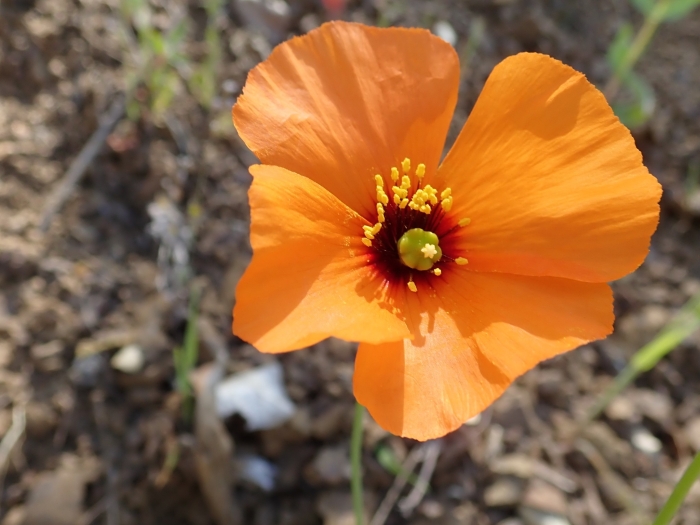Windpoppy
(Stylomecon heterophylla)
Windpoppy (Stylomecon heterophylla)
/
/

joergmlpts
CC BY 4.0
Image By:
joergmlpts
Recorded By:
Copyright:
CC BY 4.0
Copyright Notice:
Photo by: joergmlpts | License Type: CC BY 4.0 | License URL: http://creativecommons.org/licenses/by/4.0/ | Rights Holder: joergmlpts | Publisher: iNaturalist | Date Created: 2021-04-14T18:33:58Z |



















































Estimated Native Range
Summary
Stylomecon heterophylla, commonly known as Windpoppy, is an annual herb native to the chaparral and oak woodlands of California, as well as the coastal scrub regions of Northwest Mexico. It typically grows to a height of 1 foot (0.3 meters) and a width of 0.5 feet (0.2 meters). The plant features delicate, cup-shaped orange flowers that bloom in the spring and are quite showy, attracting pollinators such as bees. The foliage is deeply lobed and provides a soft green backdrop for the bright blooms.
Windpoppy is valued for its vibrant springtime flowers and its ability to thrive with minimal care, making it a suitable choice for wildflower gardens, informal borders, and naturalized areas. It is often used to add a splash of color in meadow plantings or as part of a mixed annual display. In cultivation, Windpoppy prefers part shade but can tolerate full sun in cooler climates. It is drought-tolerant once established and can adapt to a range of soil types, though it prefers well-drained soils. While generally free from serious pests and diseases, it can suffer from root rot in overly wet conditions. As an annual, it completes its life cycle in one year and can reseed itself under favorable conditions.CC BY-SA 4.0
Windpoppy is valued for its vibrant springtime flowers and its ability to thrive with minimal care, making it a suitable choice for wildflower gardens, informal borders, and naturalized areas. It is often used to add a splash of color in meadow plantings or as part of a mixed annual display. In cultivation, Windpoppy prefers part shade but can tolerate full sun in cooler climates. It is drought-tolerant once established and can adapt to a range of soil types, though it prefers well-drained soils. While generally free from serious pests and diseases, it can suffer from root rot in overly wet conditions. As an annual, it completes its life cycle in one year and can reseed itself under favorable conditions.CC BY-SA 4.0
Plant Description
- Plant Type: Herb
- Height: 1-2 feet
- Width: 0.25-0.5 feet
- Growth Rate: Moderate
- Flower Color: Orange
- Flowering Season: Spring
- Leaf Retention:
Growth Requirements
- Sun: Part Shade
- Water: Low, Medium
- Drainage: Fast, Medium, Slow
Common Uses
Bee Garden, Bird Garden, Deer Resistant, Low Maintenance, Rock Garden, Showy Flowers
Natural Habitat
Chaparral, oak woodlands of California, and coastal scrub regions of Northwest Mexico
Other Names
Common Names: Flaming-Poppy , Wind-Poppy , Vindvallmo
Scientific Names: Stylomecon heterophylla , Papaver heterophyllum , Meconopsis heterophylla , Stylophorum heterophyllum , Stylomecon heterophylla var. micropetala , Meconopsis crassifolia , Papaver crassifolium , Papaver heterophyllum var. crassifolium , Stylophorum crassifolium
GBIF Accepted Name: Stylomecon heterophylla (Benth.) G.Taylor